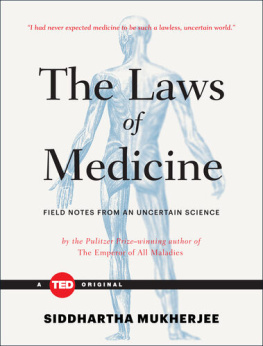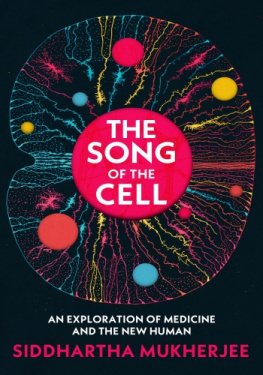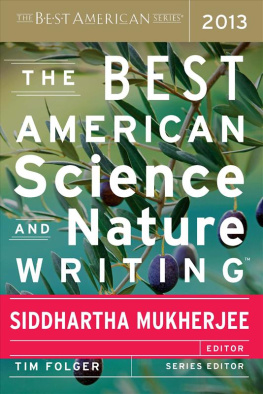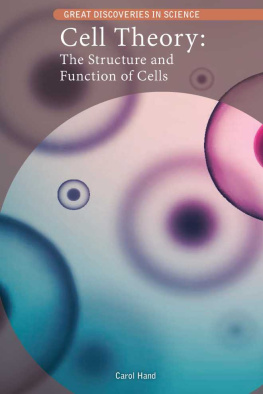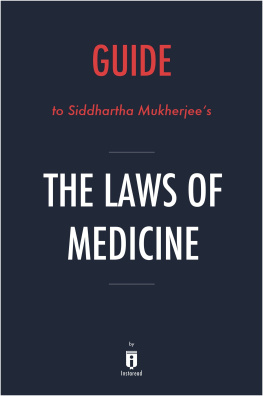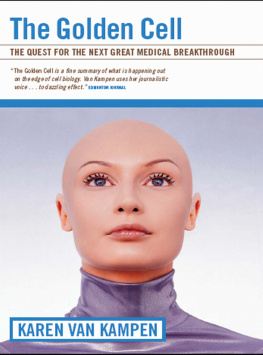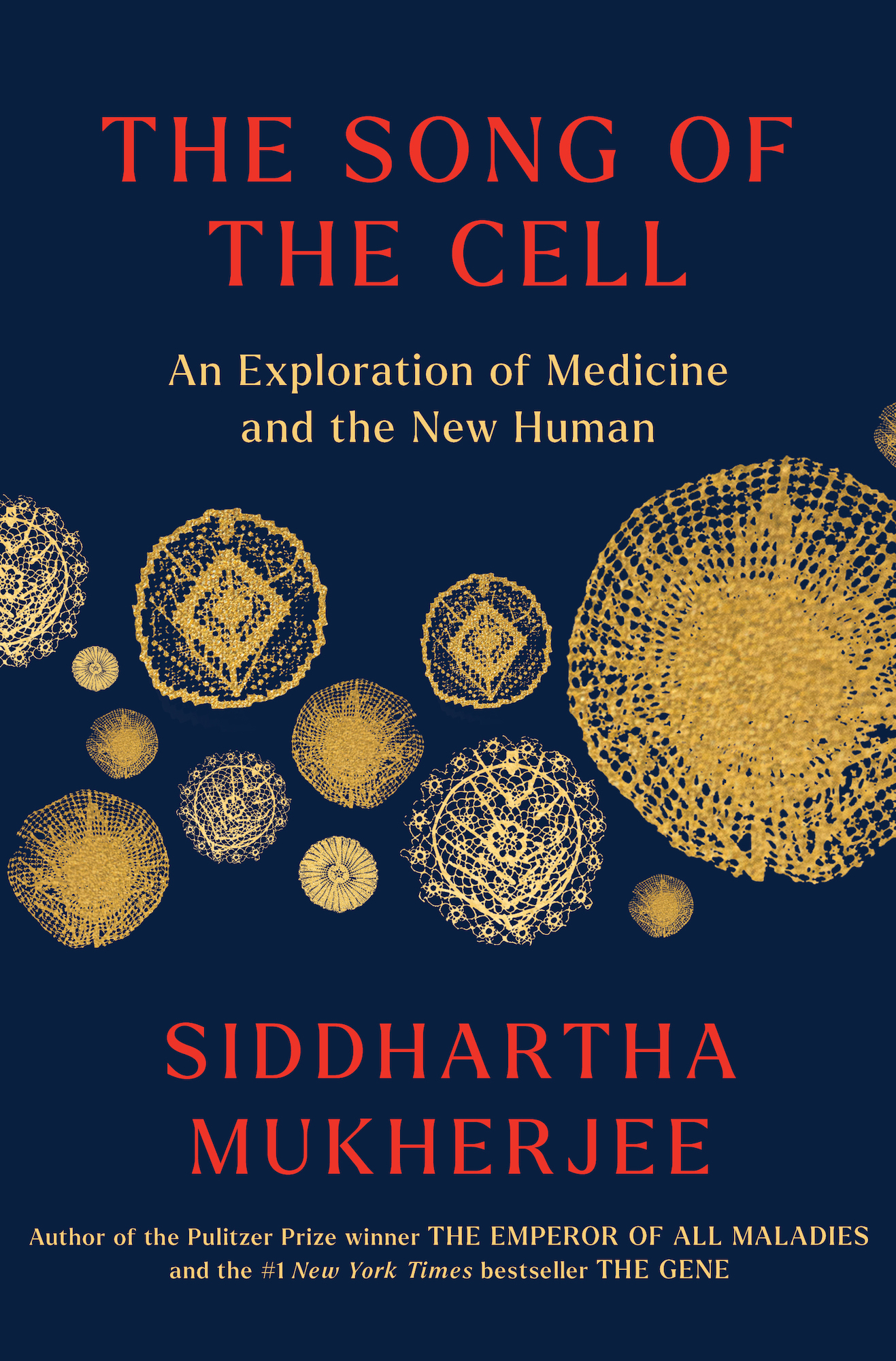Contents
Guide
The Song of the Cell
An Exploration of Medicine and the New Human
Siddhartha Mukherjee
Author of the Pulitzer Prize winner The Emperor of All Maladies and the #1 New York Times bestseller The Gene

SCRIBNER
An Imprint of Simon & Schuster, Inc.
1230 Avenue of the Americas
New York, NY 10020
www.SimonandSchuster.com
Copyright 2022 by Siddhartha Mukherjee, M.D.
Certain names and identifying details have been changed.
All rights reserved, including the right to reproduce this book or portions thereof in any form whatsoever. For information, address Scribner Subsidiary Rights Department, 1230 Avenue of the Americas, New York, NY 10020.
First Scribner hardcover edition October 2022
SCRIBNER and design are registered trademarks of The Gale Group, Inc., used under license by Simon & Schuster, Inc., the publisher of this work.
For information about special discounts for bulk purchases, please contact Simon & Schuster Special Sales at 1-866-506-1949 or .
The Simon & Schuster Speakers Bureau can bring authors to your live event. For more information or to book an event, contact the Simon & Schuster Speakers Bureau at 1-866-248-3049 or visit our website at www.simonspeakers.com.
Interior design by Davina Mock-Maniscalco
Jacket design by Jaya Miceli
Jacket artwork Kiki Smith, Courtesy Pace Gallery
Library of Congress Cataloging-in-Publication Data has been applied for.
ISBN 978-1-9821-1735-1
ISBN 978-1-9821-1737-5 (ebook)
To W.K. and E.W.among the first to cross
In the sum of the parts, there are only the parts.
The world must be measured by eye.
Wallace Stevens
[Life] is a continuing rhythmic movement, of the pulse, of the gait, even of the cells.
Friedrich Nietzsche
PRELUDE The Elementary Particles of Organisms
Elementary, he said. It is one of those instances where the reasoner can produce an effect which seems remarkable to his neighbor, because the latter has missed the one little point which is the basis of the deduction.
Sherlock Holmes to Dr. Watson, in Sir Arthur Conan Doyle, The Crooked Man
One of the two diners, Matthias Schleiden, was a botanist. He had a prominent, disfiguring scar across his forehead, the remnant blemish of a prior suicide attempt. The other, Theodor Schwann, a zoologist, had sideburns that descended to his jowls. Both worked under Johannes Mller, the eminent physiologist at the University of Berlin.
Schleiden, a lawyer turned botanist, had been studying the structure and development of plant tissues. He had been hay gathering (Heusammelei), as he called it, and collected hundreds of specimens from the plant kingdom: tulips, dog hobble, spruce, grasses, orchids, sage, linanthus, peas, and dozens of kinds of lilies. His collection was prized among botanists.
That evening, Schwann and Schleiden were discussing phytogenesisthe origin and development of plants. And what Schleiden told Schwann was this: in looking through all his plant specimens, he had found a unity in their construction and organization. During the development of plant tissuesleaves, roots, cotyledonsa subcellular structure, called the nucleus, became prominently visible. (Schleiden did not know the function of the nucleus but recognized its distinctive form.)
But perhaps more surprisingly, there was a deep uniformity in the construction of the tissues. Each part of the plant was built, bricolage-like, out of autonomous, independent unitscells. Each cell leads a double life, Schleiden would write a year later, an entirely independent one, belonging to its own development alone; and an incidental one, in so far as it has become part of a plant.
A life within a life. An independent living beinga unitthat forms a part of the whole. A living building block contained within the larger living being.
Schwanns ears pricked up. He, too, had noted the prominence of the nucleus, but in the cells of a developing animal, a tadpole. And he, too, had noted the uniformity in the microscopic construction of animal tissues. The unity that Schleiden had observed in plant cells was, perhaps, a deeper unity that ran through life.
An inchoate but radical thoughtone that would swerve the history of biology and medicinebegan to form in his mind. Perhaps that very evening, or soon after, he invited Schleiden (or dragged him, possibly) to the lab at the anatomical theater, where Schwann kept his specimens. Schleiden looked through the scope. The developing animals microscopic structure, including the prominently visible nucleus, Schleiden confirmed, looked almost identical to that of the plants.
Animals and plantsas seemingly different as living organisms could be. Yet, as both Schwann and Schleiden had noticed, the similarity of their tissues under the microscope was uncanny. Schwanns hunch had been right. That evening in Berlin, he would later recall, the two friends had converged on a universal and essential scientific truth: both animals and plants had a common means of formation through cells.
In 1838, Schleiden collected his observations in an expansive paper entitled Contributions to Our Knowledge of Phytogenesis. A year later, Schwann followed Schleidens work on plants with his tome on animal cells: Microscopical Researches into the Accordance in the Structure and Growth of Animals and Plants. Both plants and animals, Schwann posited, were similarly organizedeach an aggregate of fully individualized independent beings.
In two seminal works, published about twelve months apart, the living world converged to a single, sharp point. Schleiden and Schwann werent the first to see cells, or to realize that cells were the fundamental units of living organisms. The acuity of their insight was in the proposition that a deep unity of organization and function ran through living beings. A bond of union connects the different branches of life, Schwann wrote.
Schleiden left Berlin for a position at the University of Jena in late 1838. And in 1839, Schwann left, too, for a position at the Catholic University in Leuven, Belgium. Despite their dispersal out of Mllers lab, they kept up a lively correspondence and friendship. Their seminal work on the foundations of cell theory is indubitably traced back to Berlin, where they had been intimate colleagues, collaborators, and friends. They had found, in Schwanns words, the elementary particles of organisms.
This book is the story of the cell. It is a chronicle of the discovery that all organisms, including humans, are made of these elementary particles. Its a story of how cooperative, organized accumulations of these autonomous living unitstissues, organs, and organ systemsenable profound forms of physiology: immunity, reproduction, sentience, cognition, repair, and rejuvenation. Conversely, it is the story of what happens when cells become dysfunctional, tipping our bodies from cellular physiology into cellular pathologythe malfunctioning of cells precipitating the malfunction of the body. And finally, it is a story about how our deepening understanding of cellular physiology and pathology has sparked a revolution in biology and medicine, leading to the birth of transformational medicines, and of human beings transformed by these medicines.

